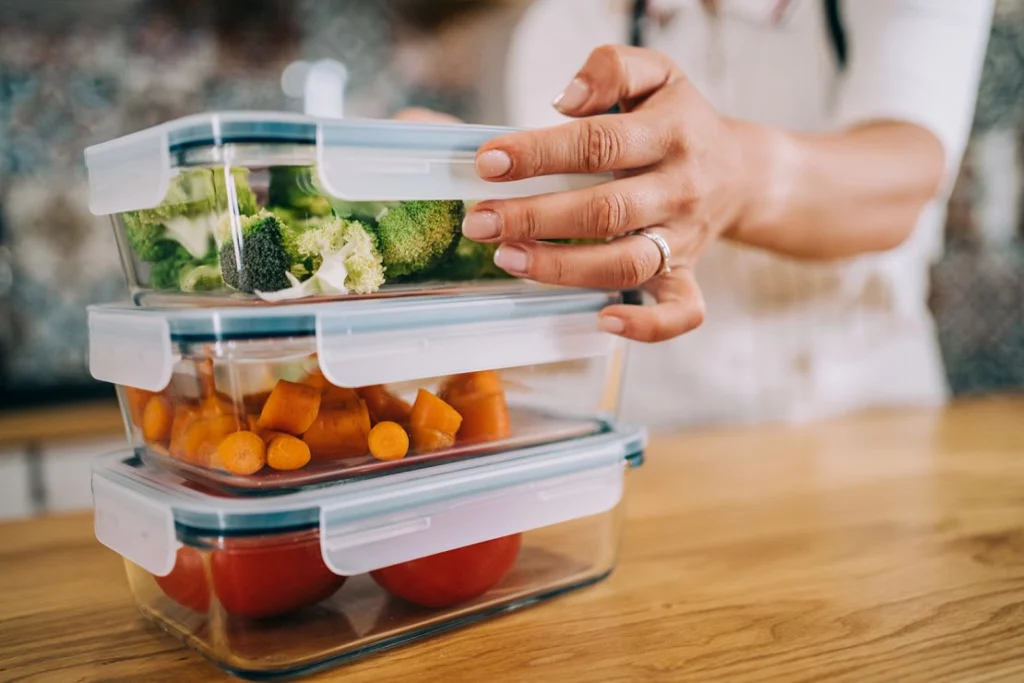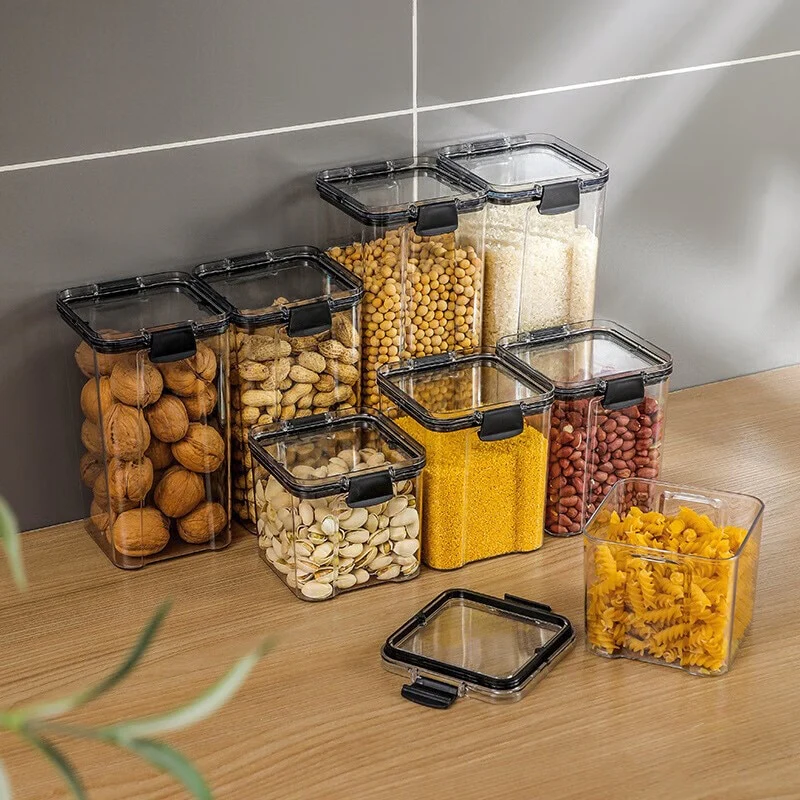Selecting the right food storage containers is crucial for maintaining food freshness, quality, and safety. The material you choose directly affects these factors and can significantly simplify your food storage routine. With options like glass, plastic, and stainless steel, understanding the strengths and limitations of each material is essential. This guide simplifies the decision-making process, helping you choose the best material for your needs. For a broader perspective, check out our main article, “Choosing The Best Food Storage Containers For Your Needs”.
Glass Food Storage Containers
Glass containers are a trusted choice for their durability, transparency, and safety. Leading brands often carry certifications such as ISO food safety standards, ensuring high-quality storage options.
Glass containers are a popular choice for their durability and non-reactive nature.
Advantages:
- Durability and Safety: Glass doesn’t leach chemicals into food, making it ideal for acidic or oily foods.
- Versatility: These containers are oven-safe, making reheating and cooking convenient.
- Visibility: Transparent material allows you to easily identify contents.
Disadvantages:
- Weight: Glass is heavier, making it less portable.
- Fragility: Care is required to prevent breakage, as glass is less impact-resistant than other materials.
- Cost: Typically more expensive than plastic options.
Glass is excellent for long-term storage of sauces, leftovers, and baked goods. Find reliable glass food storage containers in the Food Storage Containers category.
Plastic Food Storage Containers

Plastic containers remain a popular option for their portability and cost-effectiveness. Look for containers labeled “BPA-free” or carrying EU food safety certifications to ensure safe usage.
Plastic containers are widely used due to their lightweight and cost-effective nature.
Advantages:
- Lightweight and Portable: Easy to transport, making them ideal for packed lunches.
- Cost-Effective: Affordable and widely available.
- Variety: Comes in multiple shapes and sizes for diverse storage needs.
Disadvantages:
- Chemical Leaching: Certain plastics may not be suitable for high temperatures; opting for BPA-free or certified food-safe plastics ensures safe usage. Opt for BPA-free or certified food-safe plastics.
- Staining and Odors: May retain odors or stains over time; regular cleaning and proper care can help maintain quality.
- Environmental Concerns: Plastic requires proper recycling to minimize environmental impact.
Plastic containers work well for short-term storage, dry goods, and transportation. Explore durable options in the Food Storage Containers category.
Stainless Steel Food Storage Containers
Stainless steel is the go-to material for durability and a modern aesthetic.
Advantages:
- Durability: Resistant to rust, corrosion, and damage.
- Eco-Friendly: 100% recyclable and long-lasting.
- Hygienic: Non-porous surface doesn’t absorb odors or stains.
Disadvantages:
- Opacity: You can’t see the contents without opening the container.
- Heating Limitations: Not suitable for use in microwaves, but works well for other storage needs.
- Cost: Generally more expensive than plastic options.
Stainless steel is perfect for storing leftovers, meal prep, and bulk foods. Find durable and stylish options in the Food Storage Containers category.
Comparison Chart: Glass vs. Plastic vs. Stainless Steel
| Feature | Glass | Plastic | Stainless Steel |
| Durability | High (but fragile) | Moderate (prone to wear) | Very High |
| Portability | Low | High | Moderate |
| Chemical Safety | Excellent (non-reactive) | Variable (choose BPA-free) | Excellent |
| Ease of Cleaning | Easy (dishwasher-safe) | Moderate (can stain) | Easy (non-porous) |
| Cost | High | Low | High |
| Environmental Impact | Recyclable | Plastic can have a longer decomposition time unless properly recycled | Recyclable |
| Best For | Long-term storage, oven use | Short-term storage, portability | Bulk storage, meal prep |
Factors to Consider When Choosing Material
Purpose
Are you storing food for short-term use, transporting meals, or keeping leftovers?
- Short-term storage: Plastic is lightweight and portable, making it an excellent choice for packed lunches or snacks on the go.
- Long-term storage: Glass or stainless steel offers superior durability and safety, ensuring your food remains fresh without concerns about chemical leaching.
Food Type
- Acidic or oily foods: Glass or stainless steel is highly recommended as these materials do not react with the food, preserving its taste and quality.
- Dry goods: Plastic is ideal for pantry staples like cereals, nuts, or pasta due to its lightweight and space-efficient design.
Environmental Impact:
- Glass and stainless steel are more sustainable choices compared to plastic, as they are both recyclable and have longer lifespans. If you opt for plastic, look for recyclable or reusable options to minimize waste.
Budget
- While plastic is budget-friendly and accessible, consider glass or stainless steel as long-term investments. They may have higher upfront costs, but their durability and reusability often make them more economical over time.
Related Food Service Supplies
Selecting the right food storage containers is just one part of optimizing your food service operations. Explore other essential categories:
- Disposable Cutlery: Ideal for quick, hygienic solutions in food service.
- Take Away Bowls: Perfect for serving soups, salads, and more.
- Take Away Boxes: Great for transporting meals securely and sustainably.
For guidance on choosing these products, refer to our comprehensive buying guides like “Food Service Supplies: Selecting The Right Products”.
Final Thoughts
We hope this guide has provided valuable insights into selecting the ideal food storage containers for your needs, whether you prioritize material compatibility, safety, or environmental impact. From glass to plastic to stainless steel, understanding the strengths and limitations of each material helps you make informed decisions for your home or food service operation.
Explore our full range of Food Storage Containers on Droppe, where trusted brands and high-quality options are just a click away.
Still have questions or need personalized advice on finding the perfect container for your needs? Feel free to reach out—our team is always here to help you make confident and informed choices.
– The Droppe Team
Frequently Asked Questions
Yes, but ensure they are labeled freezer-safe to prevent cracking or breaking due to temperature changes.
Most stainless steel containers are dishwasher-safe, but check the manufacturer’s guidelines to be sure.
Avoid storing heavily pigmented foods like tomato sauce, or use a light coating of oil inside the container before adding food.
Glass and stainless steel are fully recyclable. For plastic, check local recycling guidelines as not all types are accepted.
For glass and stainless steel, use a baking soda and water paste. For plastic, soak in a mixture of vinegar and water.

















